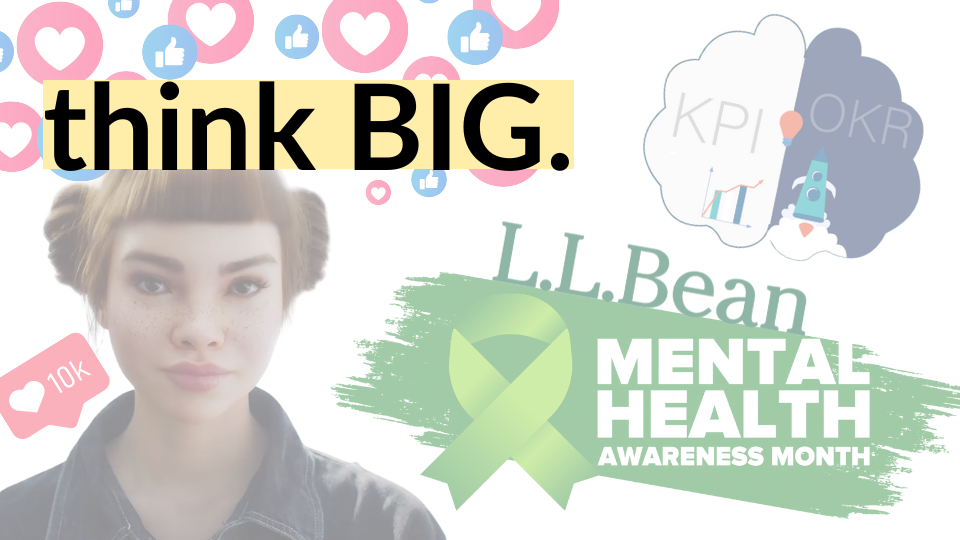Bold Brand Ideas: L.L.Bean pauses social for Mental Health Awareness Month
L.L.Bean is putting its people and purpose first with their “Off the Grid” announcement. In recognition of Mental Health Awareness Month, the brand is pausing all social channels. They’re encouraging employees and followers to prioritize outdoor time instead. L.L.Bean is also partnering with social fitness app Strava as part of their Feel-Good Challenge. They’re encouraging users to get a combined 500,000 hours outside in May. Participation in the challenge raises money for Mental Health America.
Kudos to L.L.Bean for shaking up its strategy in an era of hyper-connectedness and online shopping. With the rise of e-commerce sales ($80B to be exact), social is paramount to success. Risking sales, L.L.Bean’s pause is bold – and brilliant.
As senior marketers, we’re responsible for the positive and negative impacts of our work. While social can support self-expression and connectivity, it can also fuel anxiety and depression. Social media managers know this conundrum all too well.
But let’s be clear: L.L.Bean’s announcement is as strategic as it is socially aware. It aligns with their commitment to employee well-being, social impact programs and outdoor products. We can speculate how much gear has already been purchased for their Feel-Good challenge.
“Off the Grid” makes business sense because it nurtures the triple bottom line: people, planet and profits. The triple bottom line can elevate brand reputation, increase sales and boost employee retention + productivity. It’s a win, win, win.
As an industry, we need more bold ideas, like L.L.Bean’s social hiatus, to foster meaningful change – change that benefits brands, employees and everyday users.
Industry Insights: AI, influencers and the authenticity saga
AI influencers have entered the chat. Known as virtual influencers, these digital avatars are AI-generated, blurring the lines between robot and person. They’re managed by real people who oversee their content, relationships and collaborations. They even score deals with global brands like Dior, Prada and Nike.
Digital avatars pile on the rising distrust of the $21B influencer industry. They epitomize the crossroads we’re at as a society. People are craving human interaction, genuine relationships and realness – from peers, influencers and brands. Meanwhile, technology is propelling in the opposite direction with computer-generated content and creators.
These avatars also raise ethical concerns around body image perception, deep fakes and potential cultural appropriation.
Are they AI or are they human?

Avatars aside, influencers have become a saturated market sprinkled with cynicism from consumers. Most recently, consumers slammed influencers pretending to attend Coachella just for the content. The once beloved celebrity and mega influencers are also losing their appeal, with just 11% of US adults believing an influencer with millions of followers is trustworthy.
All that said, senior marketers continue investing in influencers, and for good reason. Brands report earning $5.20 for every dollar spent on influencers. This potential ROI is worth the investment and requires a thoughtful strategy. When done with intention and integrity, influencers are excellent at growing relationships (and revenue) for brands.
Aspirational mega influencers and celebrity partnerships have their time and place. They can be great for mass awareness and buzz (looking at you, TikTok star Alix Earle). On the flip, niche creators often drive better engagement among audiences with shared values and interests. Micro influencers are intertwined in tight communities and can build brand relationships based on trust.
IMO: the best campaigns are inclusive, culturally relevant and human. They don’t partner with digital avatars, they look beyond Zillennial social media superstars and they include creators that represent real people. Read more on this approach in our influencer relations blog.
Goals: KPIs vs. OKRs in the quest for better measurement
We’ve been having conversations with clients and colleagues about OKRs (Objectives + Key Results) vs. KPIs. Although not a new concept, it’s a hot topic amongst senior marketers as performance demands grow.
Here’s how we’re describing the differences:
- KPIs are static business metrics that measure annual performance. They are often set and left with little opportunity for ongoing optimization. Building campaigns around KPIs is, of course, important, but those campaigns will perform best when OKRs are attached.
- OKRs describe quarterly goals and are used to decide what tactics are used along the way. They provide a framework for setting, monitoring and achieving goals – which may mean adjusting strategy where needed. This approach is especially helpful for understanding and reporting the impact of brand building campaigns.
To set OKRs, start with the framework: “I will [objective] as measured by [key result].“ OKRs can have both quantitative and qualitative key results. Examples:
- “I will increase product awareness by driving 1 million visitors to our website.”
- “I will improve brand affinity by surveying, analyzing + addressing customers’ concerns.”
Although OKRs are made to be flexible, they should also be measurable. They empower brands and their agency partners with a comprehensive goal-setting framework that more clearly and effectively connects marketing campaigns to business objectives.
With Q2 well underway, now is a great time to evaluate annual benchmarks and build quarterly roadmaps for maximized success.
That’s it for May. Thanks for thinking bigger with us!





